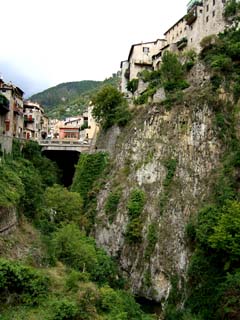 |
Luceram is a beautiful
little town that seems relatively unaffected by the flux of tourists in
the region by virtue of being just far enough off the beaten
path. It seems that in medieval times most of the population
sought shelter from pirates by heading inland and building their towns
in inaccessible places like this one which is on top of a narrow ridge
between two gorges. Now it is protected from tourists by
virtue of some 30 kilometers of windy road from Nice. This
protection from invaders was
effective on the digestive system of my four year old daughter and
nearly sent us home as well. |
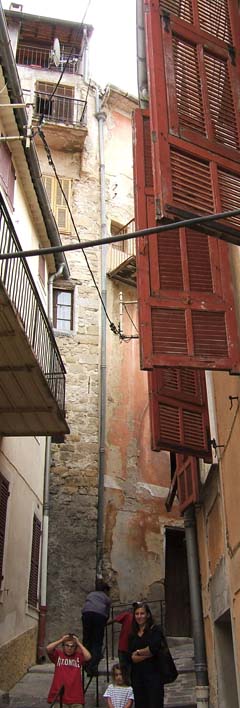 |
The "streets" are so narrow and steep that they are
really more like stairways. The buildings are stacked one atop
the other in successive remodelings and reuses of older
structures. The buildings are often six stories high but I
suspect they got that way slowly. Note the satellite dish, power
cables and ancient rock work
|
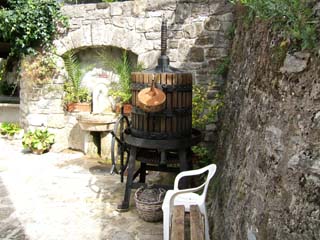
|
Like a lot of Europe there
are plentiful remnants of past effort like this wine press which was
placed in a small public terrace with flowers and various
other inviting features. Note the ubiquitous plastic chair.
I almost moved it to take
this picture before I realized how important it was. Presented
here for the visitor's pleasure is the stark contrast between those
things that are preserved over time and those (like the plastic chair)
that will be used for a while, then discarded. I'm sure that wine
presses like this one were tossed in the dump by the hundreds when
better solutions became available. The few that remain are now
seen as precious. Plastic chairs by the millions are made, used,
become brittle and are tossed. In fifty years
they may become rare enough to be seen as a precious icon of this
period in history. For now we try to ignore them.
|

|
Some of the routes through Luceram are staircases that tunnel
under buildings to emerge on a higher street. The adjacent houses
often have doors or windows into these dark
spaces. The overall effect is like some secret passage that
departs one place and time and travels to another. Here we are
leaving the part of the city that is accessible by car to enter the
quiet pedestrian village beyond. Note the
absence of handrails, lighting or other safety code related
requirements we Americans expect. This too is a remnant of a time
past (when people didn't sue for
their own stupidity).
|
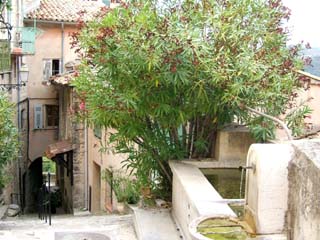
|
Also left over from not so
long ago are little fountains that were scattered about town for the
convenience of those who did the laundry. They're still
functional and are used for the occasional item that doesn't fit in
the washer. Seeing these fountains makes me wonder about how
life must have changed when you no longer met your neighbors for gossip
while you labored over you family's dirt. There must have been a
shared understanding of your lot in life as you literally "aired your
dirty laundry". It has only been a few
decades since we started to expect so much privacy and loneliness in
our troubles.
|
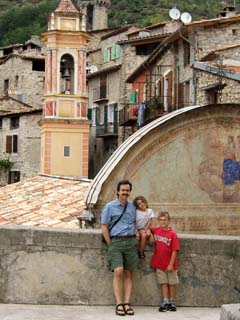 |
There are at least three
churches in this small town. In the back ground, note the clock
tower of this older church is no longer higher than the surrounding
buildings and one fellow's terrace looks directly at the
churchbell. For a sculptor it was fun to see the composition of
structures jumbled at various angles to one another and the texture of
the clay
tile roofs against the rock work. Ah, then throw in the
occasional
satellite dish as you look towards the very back of town and its
thirteenth century
guard tower.
|
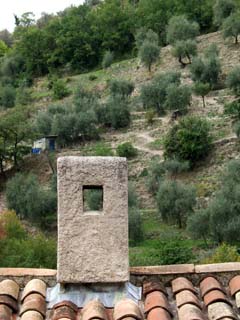
|
The town is very compact and
surrounded only by terraced gardens on the steep hills.
|
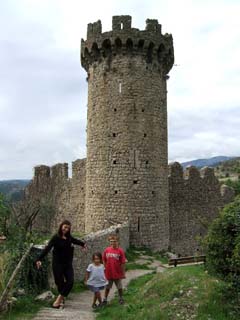
|
Here we are at the outskirts
of
town. The town is made mostly of multistoried buildings right to
the edge of town. Then it just stops. No cascade of suburbs
or
even villas in the surrounding area. Just gardens which are
themselves increasingly disused. This is the invaders side of the
thirteenth century guard tower and ramparts. It is a big
sculpture to me, a crumbling monument to a previous lifestyle,
displayed on a rock in
the mountains, that just happens to have people living in it all the
time. It is being lovingly preserved by the inhabitants who seem
to have a remarkable understanding of what they have.
|
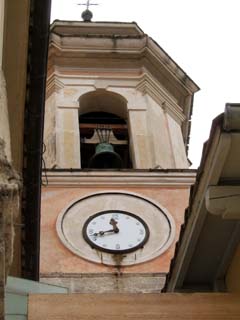
|
Central to any town here is
the
clock tower. This one is at the Saint Margarite church which is
known for the high quality artwork that adorns its interior (no photos
allowed).
|
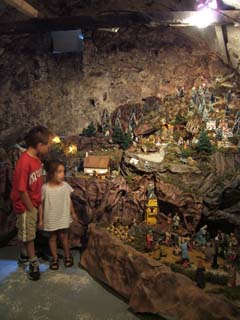 |
We were lucky enough to have
the operator of the Crèche Museum come and open up for us to
visit. It was suprising to see a museum dedicated entirely to
"Crèche" which is another word for the little nativity scenes
depicting
the baby Jesus in Bethlehem that are set out at Christmas. When I
was a kid we had one that was made in the US and one from Mexico.
My wife has one that is from Peru. Every Christian culture
develops a scene to match their ideas of what the event must have been
like. This museum must have had over a hundred different
crèches. Here is an elaborate Provençal
crèche that depicts
medieval Luceram.
|
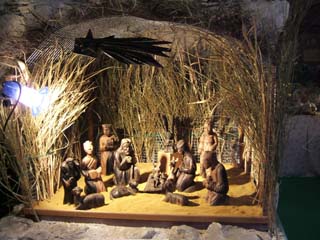 |
They have crèche from
far
away places like this one from somewhere in Africa.
|
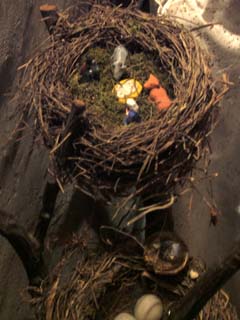 |
They have crèche in a
wide
variety of settings and containers. Here is a crèche built
in a
birds nest.
|

|
This crèche is a
unique one
made most entirely from one gourd. The all the characters are
carved from the seeds.
|
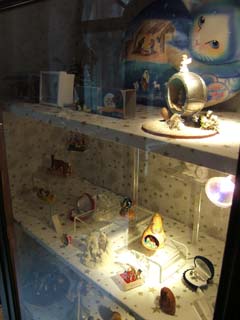
|
Here are some tiny
crèche in
things like a walnut shell, a matchbox and a sawn open Petanque ball
(upper right).
|
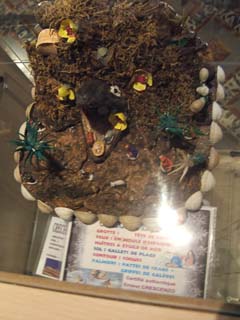
|
Even after all of that, this one surprised me: a crèche
in the
mouth of an eel. (We originally went to Luceram in order to visit
a small museum
dedicated to old tools. Unfortunately, the operator was busy that
day
and so it was closed. I'm not sure I would have taken the time to
consider crèches had it been open. It makes me think of
Robert
Bricker's comment that he prefers religious art because it is about the
religion and art but not the glory of the sculptor or his patron.)
|














